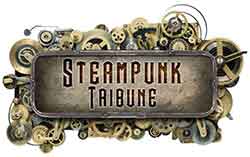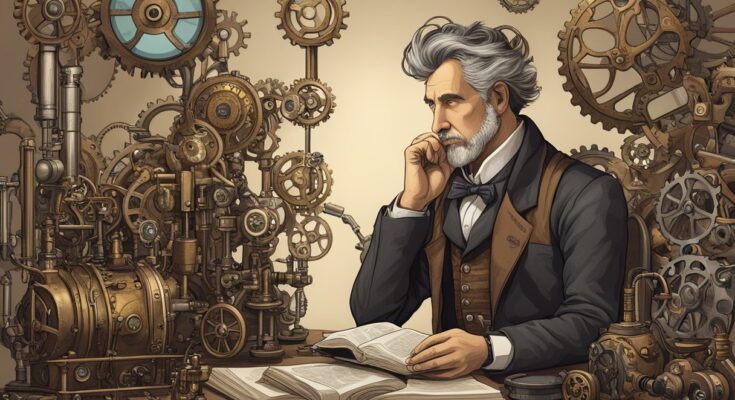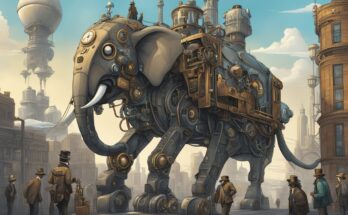Steampunk, a genre blending Victorian-era aesthetics and futuristic inventions powered by steam, has captivated the imagination of creators and enthusiasts worldwide. Its origins are often traced back to the works of three pioneering authors: H.G. Wells, Jules Verne, and K.W. Jeter. Wells and Verne laid the foundation for science fiction with their 19th-century novels, which featured elements such as time travel and fantastical machines that later became staples in steampunk literature.

K.W. Jeter is credited with coining the term “steampunk” in the 1980s to describe the retro-futuristic and alternative history works that he, along with authors like Tim Powers and James Blaylock, were writing at the time. These works were set in a 19th-century that never was, incorporating advanced technologies as if conceived within the period’s material and social framework. This concept has since blossomed into a rich and diverse subculture, extending beyond literature to fashion, film, and visual arts, unified by the anachronistic fusion of past and future.
Today steampunk is recognized not just for its distinctive aesthetic but as a movement that encourages innovation, creativity, and a unique reinterpretation of history. While Wells and Verne provided the visionary ideas, and Jeter named and nurtured the genre, the spirit of steampunk continually evolves with each new creator who brings their ideas to life within this imaginative framework.
Origins and Evolution
The evolution of steampunk as a genre is a tapestry interwoven with historic inspirations, literary genius, and artistic innovation. The movement encapsulates an era of technological romance and historical re-imaginings that continue to evolve.
Key Authors and Works
Notable in the steampunk genre are the works of Jules Verne and H.G. Wells. Verne’s “Twenty Thousand Leagues Under the Sea” offered groundbreaking technological fantasy, while Wells’ “The Time Machine” presented a techno-social narrative. Modern authors like K.W. Jeter, Tim Powers, and James Blaylock further expanded the genre with works such as “The Anubis Gates,” “Morlock Night,” and “Infernal Devices.”
Historical Context
The Victorian Era, with its Industrial Revolution backdrop, provides the historical context where steampunk takes root. This period in the 19th century witnessed a fusion of science and technology with societal and cultural progress, which later became stepping stones for steampunk narratives.
Literary Predecessors
Steampunk literature drew from speculative fiction, a domain that marries fantasy and alternate history with technological innovation. The Victorian literary environment shaped by the works of its progenitors such as Verne and Wells, heralded the dawn of science fiction, laying the groundwork for the steampunk genre.
Seminal Figures
Jules Verne and H.G. Wells are often considered the seminal figures of the steampunk movement due to their role in pioneering the combination of science fiction with Victorian-era technological imagination. K.W. Jeter notably coined the term “steampunk” to describe the retro-tech genre that these authors had unknowingly birthed.
Defining the Term
The term “steampunk” was defined by K.W. Jeter as a way to represent a genre of speculative fiction that embodies the essence of the Victorian era’s technology and aesthetic. It reflects a world where steam power predominates and encompasses various elements of science fiction, fantasy, and alternate history.
Aesthetic and Design

The Steampunk aesthetic melds Victorian-era designs and a fascination with steam technology with modern sensibilities, creating a distinctive and anachronistic visual style that permeates various forms of art and design.
Visual Art
Steampunk visual art is characterized by a harmonious blend of historical elements from Victorian England and industrial machinery. Artworks often depict scenes infused with mechanical devices and gears, set against the backdrop of the 19th century. This fusion is evident in various media, from oil paintings to digital illustrations, each detail meticulously crafted to reflect the era’s culture while integrating futuristic technology.
Fashion Elements
Fashion within the Steampunk genre is a direct nod to Victorian fashion, generously accessorized with elements inspired by the Age of Steam. Key fashion items include:
- Top hats and goggles: Signifiers of the Steampunk aesthetic, often embellished with gears and mechanical motifs.
- Corsets and tailcoats: Staples of Victorian attire that are reimagined to include brass buttons, leather straps, or metal accents.
These elements showcase a hybrid of antiquated style with a practical, mechanically-influenced design.
Architectural Style
Steampunk architecture combines Victorian design and modern mechanical concepts to create structures that appear as though they belong to an alternate history. Characteristics such as ornate detailing, exposed brick, and visible mechanical systems transform buildings into works of Steampunk art. The style emphasizes the beauty of function and the elegance of the industrial era within architectural spaces.
Everyday Objects
Everyday items in the Steampunk realm undergo a transformation to reflect the aesthetic’s unique design principles, incorporating both beauty and utility. Objects might feature:
- Brass and copper accents: Providing a vintage, industrial look.
- Gauges and valves: Celebrating the mechanical basis of Steampunk culture.
These design choices merge Victorian elegance with technological imagination, ensuring even the most mundane items receive a touch of whimsical yet functional Steampunk flair.
Cultural Impact
The steampunk genre has permeated various facets of culture, creating vibrant communities, influencing media, and inspiring works across literature, gaming, and music. It intertwines elements of the Victorian era with machinery, fantasy, and punk aesthetics, marking a distinctive presence in contemporary subcultures.

Subcultures and Communities
Steampunk subculture is a rich blend of Victorian elegance and industrial machinery, often celebrated at conventions worldwide. These gatherings not only showcase the art and fashion of steampunk but also serve as crucial hubs where enthusiasts can exchange ideas and collaborate. The subculture has given rise to distinct communities, creating spaces where individuals share a passion for the re-imagined 19th-century steam-powered future.
Media Influence
Steampunk has left a notable imprint on films and anime, integrating its aesthetic into various storylines and visual settings. Radio 4 has broadcast steampunk-themed programs, while YouTube creators frequently post content related to DIY steampunk projects, tutorials, and film reviews, expanding the genre’s reach.
Gaming
Video games have embraced steampunk in genres ranging from strategy to action and stealth games. An illustrious example is the critically acclaimed ‘Dishonored’ series, which incorporates steampunk design and narrative elements, immersing players in a richly crafted world.
Literature and Publishing
Steampunk’s influence in literature is seen in numerous works that combine science fiction with alternative-history Victorian settings. The genre’s penchant for speculative technology and steam-powered machinery has spurred a whole sub-genre of literature, contributing significantly to the diversity of reading and publishing.
Music and Performance
Music within the steampunk realm often fuses modern styles with archaic sounds, resonating with the genre’s juxtaposition of old and new. Steampunk music and performances, sporting DIY instruments and Victorian-flavored attire, not only entertain but also act as dynamic expressions of steampunk culture.
Steampunk’s cultural impact is enduring and diverse, resonating through various channels of expression. Each subsection of the steampunk community adds to the rich tapestry that defines the genre and its place in modern culture.
Technological Inspirations

Steampunk as a genre blends the historical elements of the Victorian era with advanced technological concepts powered by steam and mechanics. Its technological inspirations derive from a combination of scientific principles, the contributions of historical inventors, and the imaginative application of mechanical devices.
Influences from Science
The backbone of Steampunk is rooted in the scientific discoveries and theories from the 19th century. This period was marked by a surge in understanding thermodynamics, which paved the way for the era’s obsession with steam power and mechanical propulsion. In literature, this fascination was captured by science fiction authors who drew upon real-world technology and extrapolated it to create fantastic machines within their narratives.
- Key Scientific Areas:
- Thermodynamics
- Mechanics
- Electricity & Magnetism
The Role of Inventors
Inventors of the 19th century, like Charles Babbage and Nikola Tesla, instigated transformative changes with their work. Babbage’s design for the Analytical Engine, a precursor to modern computers, is frequently referenced in Steampunk as it resonates with the genre’s fascination with intricate machinery and computational devices.
- Notable Inventors:
- Charles Babbage
- Nikola Tesla
Mechanical Devices
Steampunk is characterized by its signature mechanical devices that embody both form and function. These include imagined versions of airships, intricate machinery, and vehicles that blend historical aesthetics with envisioned capabilities. Devices are often presented with exposed gears, brass fittings, and elaborate designs, suggesting a parallel world where steam technology progressed in extraordinary ways.
- Iconic Steam-powered Machines:
- Airships
- Steam-powered Ships
- Mechanical Computers
By integrating the allure of Victorian technological progress with fictional advancements, Steampunk offers a complex tapestry where old-world aesthetics meet futuristic innovation.
Literary Exploration
Steampunk literature intertwines elements of fantasy, history, and technology in novel ways, often credited to a distinct group of authors whose works have defined the genre.
Notable Novels and Series
- “The Difference Engine” by William Gibson and Bruce Sterling: This novel is pivotal, illustrating an alternate history where the computer age arrives during the Industrial Revolution.
- “Homunculus” by James Blaylock: A tale that represents air travel innovation, blending historical settings with whimsical plots.
- “The Steampunk Trilogy” by Paul Di Filippo: A collection of three stories that exemplify steampunk’s incorporation of pseudo-Victorian era settings and bizarre inventions.
Themes and Motifs
Steampunk fictions frequently explore:
- Alternate History: They consider “what if” scenarios, re-imagining historical turning points with advanced technology.
- Time Travel: This is a recurring motif, often used to critique or analyze the impact of technology on society.
- Fantasy Elements: Many steampunk stories include elements of fantasy, like the creation of life through alchemy or the existence of fantastical creatures.
Authors’ Contributions
- Jules Verne: Often hailed as a forefather of steampunk, his works inspire the incorporation of futuristic technology into historical settings.
- Tim Powers: He is recognized for the depth of historical and fantastical elements in his work, notably “Homunculus.”
- Mervyn Peake and Michael Moorcock: These authors have contributed to the genre with their rich and atmospheric creations that combine history, fantasy, and adventure.
Relationship with Other Genres

Steampunk’s identity intertwines with several other literary genres through shared elements of technology, culture, and setting. Its narratives often merge the aesthetics of the past with anachronistic features rooted in science fiction.
Compared to Cyberpunk
Steampunk: Emphasizes an alternative history where steam-powered technology is predominant.
- Setting: Often set in the Victorian era.
- Technology focus: Steam-powered machinery, clockwork devices.
- Cultural Aesthetic: Retrofuturistic with a focus on brass, wood, and gears.
Cyberpunk: Focuses on a dystopian future driven by advanced technology.
- Setting: Usually a near-future Earth or cybernetically enhanced societies.
- Technology focus: Advanced computers, cybernetics, AI.
- Cultural Aesthetic: High-tech, neon-lit, and often gritty urban environments.
Despite their contrasting settings and technology, both genres explore themes of societal structure and individuality within technologically saturated cultures.
Influence of Gothic and Horror
Steampunk:
- Incorporates Gothic elements by adopting a dark and mysterious atmosphere akin to Victorian gothic literature.
- Enriches narratives with settings like Victorian England, filled with fog-laden streets and a sense of the uncanny.
Horror:
- Steampunk borrows from horror‘s tension and fear elements.
- Uses speculative technology to introduce new, chilling scenarios.
By weaving these influences, Steampunk adds emotional depth and helps create a richer tapestry of speculative fantasy.
Connection to Historical Fiction
Steampunk:
- Merges Victorian era details with alternative technological advancements, offering a speculative twist on historical fiction.
- Characters and societies are frequently portrayed with historical accuracy regarding manners, language, and societal norms.
- Technology in Steampunk, although advanced or imagined, is described with a strong sense of realism akin to historical fiction’s attention to detail.
As a result, readers experience a vibrant collision of authentic historical settings with the inventive potential of science fiction.
Fashion and Lifestyle

Steampunk fashion combines Victorian aesthetics with industrial elements to create a distinctive style rooted in an alternative history where steam power dominates.
Costuming and Accessories
Steampunk ensembles are often composed of Victorian-era clothing with a twist of industrial flair. Key elements such as corsets, vests, petticoats, and tailcoats are commonly seen, often in fabrics like tweed, velvet, and leather. Accessories are vital, with items like goggles, geared timepieces, and elaborate metalwork jewelry featuring prominently. These adornments reflect the machinery aspect of the steampunk world, where functionality meets fashion.
Steampunk in Modern Fashion
Modern fashion sees steampunk aesthetics emerge in mainstream clothing lines and couture. Designers incorporate cog-and-gear motifs and Victorian silhouettes into their collections, bringing a steampunk influence to the runway and everyday wear. This blending manifests through structured suits with intricate vests, dresses with gear patterns, and the ubiquitous use of brass and bronze finishes that harken back to steampunk’s industrial roots.
DIY and Artisan Influence
The steampunk community thrives on DIY craftsmanship, with many enthusiasts crafting their own clothing and accessories. Self-made pieces emphasize the artisanal aspect and the importance of personal aesthetics. Online platforms such as Etsy provide a space for artisans to sell their hand-crafted steampunk creations, from customized clothing to unique metalwork accessories. This handcrafted approach ensures that no two steampunk outfits are alike, making personal expression and innovation central to the steampunk lifestyle.
Influence on Modern Technology

Steampunk’s aesthetic, rooted in a blend of Victorian-era sensibilities and speculative mechanical advancements, has infiltrated various facets of modern technology. These manifest in visual design and in the appreciation for intricate artisanship and the do-it-yourself (DIY) ethos.
Retrofuturistic Designs
Technological products often draw inspiration from the steampunk genre, which merges historical elements with futuristic concepts. This retrofuturistic approach is evident in various consumer electronics that bear anachronistic design features while housing cutting-edge technology. Examples include:
- Computers and keyboards: Outfitted with brass components and typewriter-style keys, maintaining high functionality with a classic aesthetic.
- Smartphones cases: Some manufacturers offer cases that mimic old-fashioned materials like leather and metal, combined with contemporary protection technology.
Craftsmanship and DIY
The steampunk movement pays homage to the skills of yesteryears’ artisans and this has carried over into modern technology with a heightened respect for craftsmanship. The influence is visible in:
- Machine assembly: Handcrafted computer casings and hardware are highly sought-after by enthusiasts who value individual craftsmanship.
- DIY communities: Online forums and workshops foster environments where individuals can share knowledge on creating and modifying technology with a steampunk twist. These communities often value sustainability, emphasizing reuse and customization.
Global Perspective

The global reach of steampunk is vast, encompassing various cultures and intertwining with history and art across the world.
Steampunk Around the World
Steampunk, as a genre and aesthetic, has transcended its origins to become a global phenomenon. In Japan, steampunk has blended with local culture and anime, leading to innovative takes on the genre. A notable example is the 1988 film Akira, which, while not steampunk in the traditional sense, incorporates many elements that have influenced the steampunk movement in Japanese media.
Around the world, steampunk’s versatility allows it to complement and redefine local cultural aesthetics. Historical events are often reimagined through a steampunk lens, offering alternative histories where steam technology reigns supreme. In art, steampunk has inspired a plethora of artistic creations, from intricate sculptures to elaborate costume designs, each tailored to reflect the unique culture it represents.
Through its deep integration into local scenes, steampunk continues to intrigue and inspire, making it a diverse and ever-evolving part of global culture.
Future of Steampunk

In the realm of speculative fiction, the future of Steampunk is anchored in its capacity for reinvention and expansion. As it evolves, the genre is likely to incorporate fresh perspectives and innovative interpretations of steam power and technology. Steampunk’s progression will be shaped by imaginative works that push boundaries while exploring themes of discovery and exploration.
Subcultures within Steampunk continue to reimagine historical periods with a creative twist, often blending elements from different eras with futuristic technology. The aesthetic is expected to influence not only literature but also various forms of media and fashion as it keeps interweaving retro-futures with modern sensibilities.
Key areas where Steampunk may thrive include:
- Literature & Media: New narratives within Steampunk will emerge, expanding the existing universe with diverse characters and settings.
- Technology & Design: Advances might be seen in combining Steampunk designs with actual technological developments, giving practical form to what started as purely aesthetic.
- Events & Communities: The subculture may see growth in Steampunk-themed events and online communities, fostering engagement and collaboration.
The table below outlines possible directions for the evolution of Steampunk:
| Area | Potential Developments |
|---|---|
| Art and Fashion | Fusion of Steampunk elements with contemporary trends. |
| Gaming | The immersion of players into Steampunk-themed virtual realities and tabletop games. |
| Makerspaces | Collaboration on Steampunk-inspired creations, blending craftsmanship with technology. |
Reflecting on its resilience and adaptability, Steampunk stands firmly on the brink of redefining not just its own narrative, but also influencing broader cultural trends. As a breeding ground for imagination, the future of Steampunk appears to be as open and variable as the paths of discovery it portrays.




